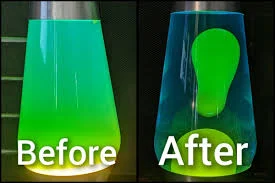For many years, lava lamps have been a common fixture in homes because they produce a soothing and captivating light show. Even though they have a fairly straightforward construction, lava lamps can occasionally have a few glitches. These problems, which can include the lava being trapped, hazy liquid, or overheating, can frequently make you question whether the lamp is irreparable. But don’t worry! We’ll examine the most typical issues with lava lamps in this troubleshooting guide and demonstrate how to resolve them.
Contents
Understanding How Lava Lamps Work
It’s crucial to comprehend the fundamentals of lava lamp operation before we begin troubleshooting. A wax combination (lava) suspended in a liquid is what makes up a lava lamp. The wax rises when the lamp is turned on because of the heat from the base bulb. The wax falls as it cools, producing a calming flow.
To produce this effect, the lamp needs the ideal ratio of heat, liquid density, and wax. A lava lamp issue may arise if any of these elements are incorrect. Let’s examine the most typical problems and their fixes.
Common Lava Lamp Problems and Their Fixes
When it comes to Liquid Motion lava lamp, several issues can arise over time, but most of them are relatively easy to fix. Let’s dive into some of the most common (lava lamp problems)and explore simple solutions to get your lamp back in perfect working order.
1. Lamp Not Heating Properly
Not heating up properly is one of the most common issues with lava lamps. Because of this, the lava may stop flowing and become trapped at the bottom.
Possible Causes
- The lightbulb can be too weak or have burned out.
- It’s possible that the lamp is not firmly plugged in.
- The bulb takes longer to heat up because the room temperature is too low.
How to Fix It
- Verify that the lightbulb is working. An incandescent bulb weighing 25 to 40 watts is commonly used in lava lamps. Replace the bulb with the appropriate one if it is dead or has insufficient wattage.
- Make sure the lamp is placed in a warm location and is properly plugged in. It often takes two to three hours for lava lamps to begin flowing correctly.
- Try moving the lamp to a warmer place or keeping it out of any chilly drafts if it isn’t heating up.
2. Cloudy Lava Inside the Lamp
Another typical issue with lava lamps is when they appear hazy instead than crystal clear. Cloudiness might detract from the lamp’s aesthetic appeal and make it less entertaining to watch.
Possible Causes
- It’s possible that the lamp was knocked over or shaken.
- Over time, the lamp’s liquid may have gotten contaminated.
How to Fix It
- Let the lamp cool completely first. To avoid disturbing the wax, do not move or shake the lamp while it is in use.
- Try operating the lamp for four to six hours, then shutting it off and allowing it to cool if the cloudiness continues. To give the wax time to settle, repeat this a few times.
- If the issue persists, think about changing the liquid. You can return the lamp for expert repair or purchase replacement fluids from certain stores.
3. Lava Not Flowing or Stuck at the Bottom
A Glitter Lava Lamp where the lava doesn’t flow is one of the most frustrating lava lamp problems. Instead of the hypnotic movement, the lava may just sit at the bottom.
Possible Causes
- There is not enough heat in the wax.
- The wax cannot flow correctly because it is too dense.
How to Fix It
- Make sure the lamp has been lit for a minimum of four hours. It can take a while for the wax to get to the proper temperature and consistency.
- Make sure the bulb has the correct wattage by checking it. It’s possible that a lower-wattage bulb won’t produce enough heat.
- While the lamp is off, gently swirl it (do not shake it!) if the issue continues. The wax clump may occasionally be broken apart by doing this.

4. Overheating of Lava Lamp
Although inadequate heating is an issue, the contrary can also happen. Lava can break up into smaller, faster-moving blobs when a lava lamp overheats, which lessens the lava’s visual appeal.
Possible Causes
- Too long has passed since the lamp was turned on.
- The wattage of the lightbulb is excessive.
How to Fix It
- After turning off the lamp, let it cool fully. Taking breaks from using your lava lamp every 8 to 10 hours is a smart idea.
- Verify the wattage of the lightbulb. To avoid overheating, replace it with the proper wattage if it is more than 40.
5. Discolored or Degraded Lava
Another issue with lava lamps is that the wax deteriorates or discolors over time. This has an impact on the lamp’s overall appearance and radiance.
Possible Causes
- The lamp is old or has been in the sun.
- It’s possible that contaminants have gotten into the bulb or the liquid has degraded.
How to Fix It
- Unfortunately, it is difficult to return the lava wax or liquid to its original condition once it has become discolored. Replacing the liquid or having the lamp refurbished are your best options.
- Keep your lamp out of direct sunshine and intense heat to avoid discoloration.
6. Lava Moving Too Fast
The soothing effect that lava lamps are known for may be diminished if the lava inside your lamp is flowing too quickly. Although less frequent, this lava lamp issue is still fixable.
Possible Causes
- The lamp is getting too hot.
- The lamp’s size is out of proportion to the power of the bulb.
How to Fix It
- Make sure you’re using the appropriate wattage bulb first. The ideal bulbs for the majority of standard-sized lava lamps are 25-watt or 40-watt models.
- Turn the lamp off for a few hours to cool down and restart it. If the issue persists, it could be a sign that the lamp is overheating.

Preventive Maintenance Tips for Lava Lamps
Numerous frequent issues with lava lamps can be avoided with routine maintenance. You can prolong the life of your light by doing the following:
Clean the Lamp Often: To maintain the lamp’s brand-new appearance, dust its outside. To remove any tough dirt, use a moist towel, but don’t get any liquid inside.
Avoid Shaking: When using a lava lamp, it should not be moved. Moving or shaking it can cause cloudiness by interfering with the wax’s flow.
Correct Bulb Wattage: Make sure you always use the bulb wattage that is suggested for your particular lamp type.
Positioning: Keep your lava lamp out of direct sunlight and extremely hot or cold areas. By doing this, discoloration and overheating problems are prevented.
When to Replace Parts of Your Lava Lamp?
Parts of the lava lamp may occasionally need to be replaced, even with your best efforts. The following items may need to be replaced if your lava lamp issue persists:
Bulbs: Check the lava lamp bulb if your lamp isn’t warming up. Replacing standard incandescent bulbs is simple.
Liquid: Replacing the liquid can be the best course of action if it gets too hazy or loses its color.
Wax: Replacing the wax entirely or even getting a new lamp can be the only option if the wax has deteriorated.
Lava Lamp Problem FAQ
1. Can you change the liquid in a lava lamp?
Yes, but the process is sensitive. You can send the light in for expert servicing, or some stores provide replacement kits.
2. What type of bulb should I use in my lava lamp?
A 25–40-watt incandescent bulb is used in the majority of lava lamps. Consult your particular model for suggestions.
3. Why is my lava lamp not flowing properly?
Examine the lightbulb and heating element. The lava can be too thick from antiquity or it might not be getting enough heat to flow.
If you know what’s causing the problem, fixing a lava lamp can be easy. With the correct strategy, most problems may be readily resolved, whether they are related to cloudiness, flow, or temperature. Many common problems can also be avoided with proper care and upkeep. You should be able to maintain the beauty and luminosity of your lava lamp for many years to come with this guidance.
Don’t be afraid to look into more options or get in touch with experts to restore your lava lamp’s magic if it keeps giving you problems.

Sarah Wilson, an accomplished writer and seasoned blogger, weaves compelling narratives that transport readers to new and uncharted worlds. With a talent for vivid storytelling and thoughtful insight, her work leaves a lasting mark, enchanting both the imagination and intellect.
